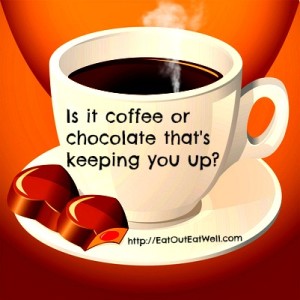
You’ve finished dinner – perhaps you’re stuffed to the gills – and some chocolate along with the check. It could be those squares nicely wrapped in shiny foil or it could be some chunks of the really dark stuff artfully arranged on a plate.
Somehow there magically seems to be some room for the chocolate to fit in your already full belly. And, just maybe, this chocolate follows a chocolate dessert that tasted so fantastic that you wanted to lick the bowl. All of that was washed down by a wonderful cup of coffee.
Then you get home and sleep is just downright elusive. You wonder why you’re wide awake since you’ve been on the go all day.
Here’s a thought – it might be the caffeine found in coffee (or tea) and chocolate. There isn’t a huge amount in chocolate, but perhaps enough – especially if you’re a chocoholic – to help tip the insomnia scales when it’s combined with a day’s worth of other caffeinated food and drinks.
Caffeine And Chocolate
Here are a couple of facts about chocolate and caffeine that most people don’t know:
Chocolate contains caffeine – not enough to give you a big time boost, but — depending on the type of chocolate, enough to register — especially if you’re working your way through some of those oversized bars or you’re a little kid stuffing in a bunch of fun-sized bars.
It would take about 14 regularly sized (1.5 oz) bars of milk chocolate to give you the same amount of caffeine that you’d get from an 8 ounce cup of coffee. Along with that little caffeine buzz you’d also be shoving in about 3,000 calories and more than 300 grams of sugar. If you’re looking for caffeine, coffee seems like a better bet at about two calories for an 8 ounce cup (black, no sugar).
Dark chocolate has more caffeine content than milk chocolate. But it would still take four regularly sized bars to get the same amount that you’d find in one cup of black coffee.
Something To Think About
The next time you find yourself reaching for those foil wrapped chocolate squares after dinner (or the ones placed on your pillow in some hotels) you might consider the caffeine if you want a restful sleep.
It’s also worth it to remember that getting kids (and some adults) to sleep on Halloween, Easter, and other chocolate heavy holidays might have a whole lot to do with both the sugar and the amount of caffeine in the chocolate candy.
- Hershey’s Milk Chocolate Bar, 1bar/1.55 oz: 9 mg caffeine
- Hershey’s Special Dark Chocolate Bar, 1 bar/1.45 oz: 20 mg caffeine
- Hershey’s Kisses, 9 pieces: 9 mg caffeine
- Hershey’s Special Dark Kisses, 9 pieces: 20 mg caffeine
- Scharffen Berger Milk 41% Cacao, ½ bar: 17 mg caffeine
- Scharffen Berger Extra Dark 82% Cacao, ½ bar: 42 mg caffeine
- Dagoba Milk Chocolate 37% Cacao, ½ bar: 9 mg caffeine
- Dagoba Dark Chocolate 73% Cacao, ½ bar: 36 mg caffeine
- Coffee, generic brewed, 8 oz: 133 mg caffeine (range: 102-200; 16 oz, 266 mg caffeine)
- Dunkin’ Donuts regular coffee, 16 oz: 206 mg caffeine
- Starbucks Brewed Coffee (Grande), 16 oz: 320 mg caffeine
- Coffee, generic instant, 8 oz: 93 mg caffeine (range 27-173)
- Espresso, generic, 1 oz: 40 mg caffeine (range 30-90)
- Starbucks Espresso, solo, 1 oz: 75 mg caffeine
- Coffee, generic decaffeinated, 8 oz: 5 mg caffeine (range 3-12)
Remember to follow Eat Out Eat Well on Facebook, Twitter, and Pinterest!